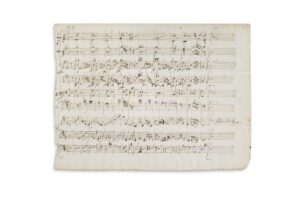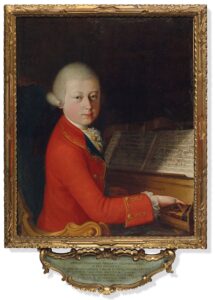
Mozart’s manuscript that sold at Sotheby’s for $413,000 in 2019.
Today we celebrate the 265th anniversary of the birth of Wolfgang Amadeus Mozart with a special entry in our provenance series. Centuries after his birth, Mozart continues to dazzle the public imagination through reinterpretations of his work, including The Magic Flute by Julie Taymor, Academy Award-winning film Amadeus, and the Amazon Prime series Mozart in the Jungle. As the works of a musical prodigy and globally-recognized composer, Mozart’s manuscripts are highly prized by collectors. One such piece, an original score with two minuets dating from 1772, sold for $413,000 (€372,500) at auction in 2019. Notably, Mozart was only 16-years-old when he created the works. The first versions of Mozart’s scores are significant because, unlike Beethoven, the young composer did not make major revisions to his drafts. This means that there are fewer copies in existence, making them both rare and valuable. Indeed, the final hammer price for this piece exceeded the projected value by nearly double.
The minuet score has an esteemed provenance; it was originally kept by Mozart’s sister Nannerl (who was an accomplished musician and composer herself), and ultimately entered the collection of Austrian writer Stefan Zweig. Upon Zweig’s death in 1986, his collection of manuscripts, including Mozart’s handwritten catalogue of works, was donated to the British Museum. The score was later acquired by Swiss bibliophile Jean-François Chaponniere, making it the only copy of an autograph composition by Mozart in private hands. Moreover, this is the only surviving copy of this particular composition in manuscript form. The other manuscripts in this minuet series are currently held by the US Library of Congress and the Gesellschaft der Musikfreunde in Vienna, Austria.
However, Mozart’s manuscripts were already setting records prior to the 2019 auction. In 1987, a private collector paid $4.4 million for a 508-page compendium of Mozart’s scores, which was the highest amount paid for a post-medieval manuscript at the time. To compare, the previous record for a musical manuscript was $544,500 for an incomplete copy of Igor Stravinsky’s “Rite of Spring” in 1982. The 1987 record was later surpassed in 2016, when a handwritten score of Gustav Mahler’s Second Symphony was auctioned for $5.6 million. Although the value of classical music compositions has risen sharply in the past few decades, this phenomenon is not free from controversy. A score attributed to Beethoven failed to sell at Sotheby’s when scholars questioned the authenticity of the work. This demonstrates the importance of establishing provenance for all types of collectible items, even those tied to musical geniuses. Fortunately, the minuet score posed no such problems, making it a true prize.

Sold for $4.4 million, the portrait of the teenage Mozart has an alluring provenance.
But private collectors’ interest in Mozart is not limited to musical manuscripts; a rare portrait of the composer as a teenager fetched €4,031,500 at auction soon after the minuet score was sold in 2019. The painting has an impeccable provenance, as it was referenced in a letter from Mozart’s father Leopold to his wife Maria Anna, dated January 1770. In 1769, Mozart had toured Italy with his father. At the age of 13, he was already a celebrity recognized for his remarkable musical talent. During Mozart’s stay in Verona, a passionate music lover commissioned a portrait of the prodigy. This is one of only five confirmed portraits of the composer painted during his short life.
What is unusual for this painting, aside from its glimpse of the composer as a young man, is the thorough documentation of the circumstances leading to its creation. Pietro Lugiati, Receiver-General for the Venetian Republic and member of a powerful Veronese family, commissioned the work while hosting Mozart and his father in Italy. The portrait depicts the teenager in a powdered wig and red frock before a Renaissance harpsichord in Lugiati’s music room. By all accounts, Lugiati was so in awe of the young Mozart he described the child as a “miracle of nature in music” in a letter to the composer’s mother and essentially detained the Mozarts for two days, until the portrait was completed.
Curiously, despite the references to the painting in contemporaneous documents, the artist remains unconfirmed. While it is likely that the painter was leading Veronese artist Giambettino Cignaroli (he referenced Mozart’s visit to his studio), an alternative attribution is Saverio della Rosa, Cignaroli’s nephew. The painting could also have been a collaboration between the two artists. Although firm attribution remains elusive, the painting was an immediate success – one of the world’s oldest newspapers, La Gazzetta di Mantova, praised the work a mere five days after it was finished – a fitting tribute to a great musician.
The Mozarteum (the house where Mozart was born) in Salzburg, Austria is currently closed due to COVID. And it is not possible for most people to purchase original manuscripts of the musical prodigy, but we can celebrate the musical genius’ birthday by listening to one of over 600 musical compositions he wrote. Happy birthday Wolfgang!